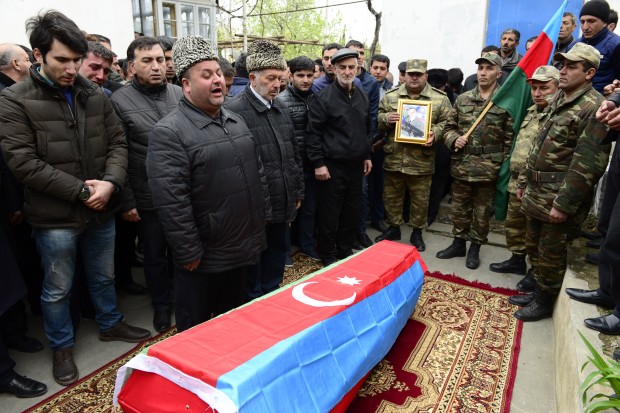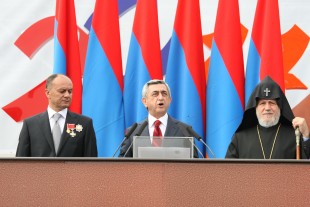What Really Happened in Nagorno Karabakh?

The Nagorno Karabakh conflict between Azerbaijan and Armenia started in 1988 with the territorial claims of Armenians over the land of Azerbaijan. Until the year of 1994 when ceasefire treaty was signed, Armenian troops occupied 20% of Azerbaijani territories including Nagorno Karabakh region and seven more districts.
On April 2, one of the bloodiest clashes began on the contact line of Nagorno Karabakh. 12 Azerbaijani soldiers were killed but there is no specific and reliable source for common deaths and injures. According to Armenian officials, Azerbaijan violated the ceasefire regime one day before and Azerbaijani officials claim that Armenians attacked military vehicles of Azerbaijan firstly.
There is an inexplicable view if we look at into details. Firstly, Armenian officials gave the exact number of Armenian casualties quickly. Generally, they don’t give any information about soldier deaths during the routine clashes on the contact line.
Secondly, all Armenian media organizations scramble to explain the situation under the keyword “Azerbaijani aggression”. This explanation has been an important tool for Armenian state policy on Nagorno Karabakh conflict by now. Most of the news about the latest clash were written with this magic word.
Thirdly, Serzh Sargsyan, Armenian president, offered a Common Defence Agreement between Armenia and the separatist administration of Nagorno Karabakh. It is important to analyze why the president has preferred this timeline to make this type of offer. Armenia which does not recognize the independence of this separatist Armenian administrative and illegally controls the region looks for a change of status quo in the region. But the status quo might be changed by a war.
Can we expect a war?
Both Baku and Yerevan are not satisfied with the casualties of numerous clashes around the contact line since 1994 when the ceasefire agreement was signed. Domestic political developments and regional politics pinned down two sides to take radical decisions.
The ‘Shant-2015’ military exercises of Armenian Defense Ministry were conducted in the first week of September 2015. Unlike during previous exercises, the public’s preparation for a possible war was measured. ‘Shant-2015’ was interesting and important because for the first time the capabilities of a country which have had serious disagreements with Azerbaijan were evaluated in a scenario of regional warfare. The general staff also underlined preparedness for geopolitical changes and transformation, and that it had informed the military attaches of foreign missions. But the public dimension of the exercise was also interesting because Armenia was able to identify its priorities in a case of total warfare.
Shortly after the ‘Shant-2015’ military exercise, Azerbaijan’s Defense Ministry held military exercises on Sept. 6-13 with 65,000 troops, 700 armored vehicles, 500 units of rocket and heavy arms equipment, 40 jets, 50 helicopters and 20 vessels taking part. The authorities had announced that the goal of the exercise was to prepare the army for potential warfare, to mobilize, bomb targets with unmanned vehicles and rockets, and to prepare the army for growing challenges. Azerbaijani media said that the exercise was a response to ‘Shant-2015’. It is also noted that military strategy for Nagorno Karabakh and Nakhchivan regions was practiced.
On one hand, the army of Azerbaijan has been modernized for several years. Azerbaijan may want to use its capacity, its modern arms and its accumulated wealth. On the other hand, there is a big desire of the Azerbaijani army to recapture the lost territories. Armenia knows very well what will happen if there would be some kind of provocations in the region towards Azerbaijan. But same Armenia does not accept the offers of Azerbaijan to withdraw Armenian soldiers from Nagorno Karabakh and other regions for reconciliation.

If we look at the side of Armenia, we can see a political conflict in domestic side. The Nagorno Karabakh problem had been a lifeline for Armenian authorities. The daily agenda of the country about illegal activities of Armenian oligarchy and corruption cases would be changed by the deaths of soldiers on the contact line. “National solidarity” issue would become a new daily agenda during this period.
The term of president Serzh Sargsyan, the head of powerful oligarchy, will come to an end in 2018. If there is no intervention to law regulations, he will not be able to rule the country but he can present a candidate.
A referendum was held in late 2015 to eliminate political risks about his rule. The referendum which was aimed at bringing about constitutional changes that would decrease the authority given to the president while increasing the power of its parliament was met by a 63 percent “yes” vote. One-half of eligible Armenian voters chose to vote. Worries are already being voiced that Sargsyan, who would not be able to be president for the third time in a row, would try to remain in a powerful position through the role of prime minister.
Sargsyan, as a former commander in Nagorno Karabakh, needs a victory during this period to intensify his power. Thus war rhetoric increases and contact line violations continue as addition to blaming Azerbaijan as an aggressor state.
It is obvious that Armenian side was expecting a big clash because Armenian websites shared several videos on the internet about the downing of Azerbaijani helicopter and bodies of dead soldiers during the day.
Some Armenian analysts blamed Ankara by claiming a possible Turkish role in the tension. They defend that Azerbaijan supports Turkey about Turkish-Russian crisis so Ankara and Baku can make new plans for the region. It seems that they want to create a general view as Armenia-Russia and Azerbaijan-Turkey alliances are clashing.
There is a necessity to find a mediator. Sargsyan is also prepared to follow any Moscow directives where the now tense Turkish-Russian relations are concerned. He may well offer any support demanded secretive military operations at the Russian military base in Gyumri.
At this period, Azerbaijan can put in hand the captured lands and might be ready to offer a reconciliation process.



2 comments
This is not true. Armenia would not jeopardize it’s peace or its people. Azerbaijan on the other hand finds great joy in harming Armenians, and goes so far as to glorify people who kill Armenians. You must also take in to consideration, that azerbaijan imprisons any journalist who dares say anything negitive about azerbaijan. Armenia does not as they are closer to a true democracy. This article is very false. It has also Been azerbaijan that has always brought up a military solution to the karabaugh issue.
Armenian side always creates provocation in the region and I am sure that Sargsyan wants a war to be super leader of his country.